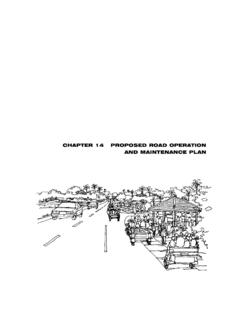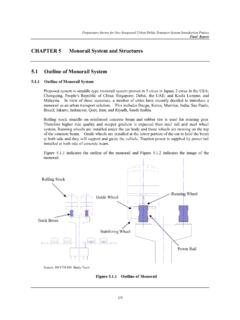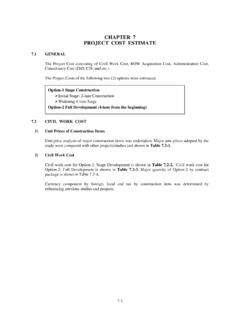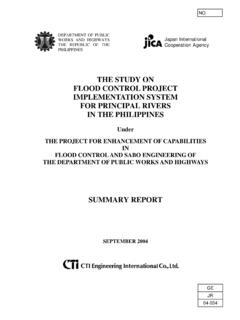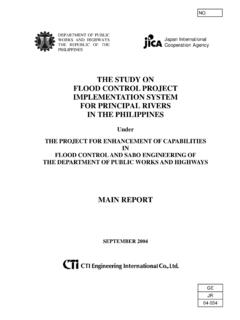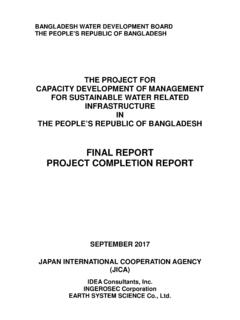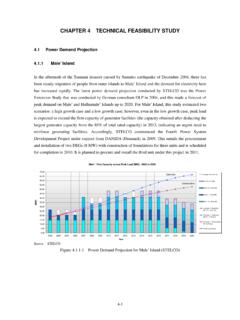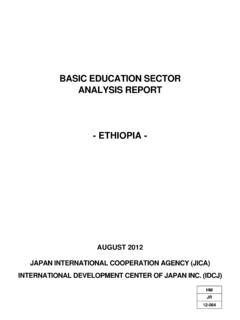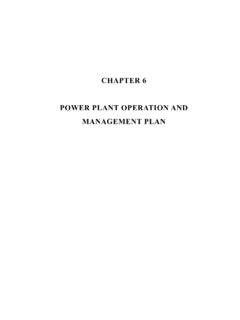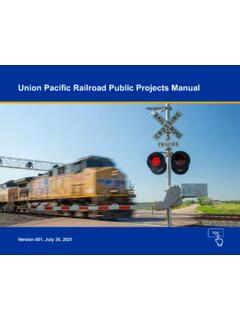Transcription of Chapter 6 ENVIRONMENTAL MANAGEMENT AND …
1 Cavite Laguna (CALA) East West National road Project: EIS Page 6-1 Chapter 6 environmental management and MONITORING PLAN INTRODUCTION The ENVIRONMENTAL MANAGEMENT and Monitoring Plan (EMMP) represents the key mitigation and enhancement measures for major impacts, which are translated into concrete action programs/projects and defines the institutional framework and mechanisms for ensuring their appropriate implementation. It likewise provides the estimated investment requirements and commitments/guarantees to carry out the proposed plan. The ENVIRONMENTAL MANAGEMENT Plan shall be composed of the following components: Design and Construction MANAGEMENT Program Social Development and Institutional Plans ENVIRONMENTAL Monitoring Plan DESIGN AND CONSTRUCTION MANAGEMENT PROGRAM Careful planning and adequate engineering design as well as observance of proper construction practices are expected to address the impacts predicted to occur during the construction and operation phases of the CALA project.
2 DPWH or its consultants shall prepare the appropriate engineering studies/plans and implement the construction program. To ensure that the roles and responsibilities of DPWH and its contractors in relation to the environment aspects are properly carried out, the Terms of Reference for such contracts should contain specific provisions pertaining to design criteria, safety considerations and observance of pertinent laws and regulations for civil works, safety and environment. ENVIRONMENTAL provisions and conditionalities must be adequately stipulated in DPWH s manual of operation and the contractors tender documents and construction activities. Compliance to these conditions will be closely monitored by DPWH in coordination with the DENR. The critical component covered by the program refers to construction MANAGEMENT since the key impacts are those generated during this phase of work.
3 During construction, the following should be closely observed: Location and set-up of construction quarters near the project site (for migrant workers only). These shall be provided with power and water supply and sanitary toilet and washing facilities. Provision of stockyard for construction materials such as aggregates, cement, reinforcing bars, among others. Identification of appropriate areas where excavated materials will be temporarily stockpiled. Coordination with LGU and DENR authorities in the identification of the disposal site for solid waste materials. Programming of land clearing and excavations during the dry season where practicable. 409 Cavite Laguna (CALA) East West National road Project: EIS Page 6-2 Inevitable removal and cutting of trees must be undertaken with permit duly authorized by the DENR.
4 Construction of temporary erosion ponds and silt traps as necessary around the work areas. Strict observance of proper cut - and - fills procedures to avoid or minimize any wastage or removal of excavated materials from the work areas. Placing of material stockpiles and spoil dumps as far away as possible from the waterways and provision of proper and adequate containment. Reduction of storage time of construction spoils and materials in the work areas. Observance of proper operational procedures in the use of heavy equipment for transporting, hauling and moving earth spoils from one area to another so as to avoid spills into the rivers or nearby waterways. DPWH must require its contractors to implement a waste MANAGEMENT program, which will include regular collection and disposal of wastes at a designated sites approved by the DENR.
5 This program should include the following waste MANAGEMENT practices: Provision of waste bins in various strategic points within the construction area for the workers to dispose their wastes. Wastes from these containers will be collected (dump truck of the contractor) regularly to be disposed at a designated dumpsite by the LGU. Placing of recyclable materials at local material recovery facilities (MRF). Conduct of a thorough orientation of workers on proper waste disposal practices. Re-use of excess excavated materials as aggregate or fill. Regular hauling of construction debris to the designated dumping area to prevent their accumulation on-site. Conduct of equipment/vehicle cleanup and maintenance as far away as possible from work areas and waterways. Collection of spent and placement of used oil placed in sealed containers and their proper disposal or sale to other users.
6 Post construction clean-up and disposal of construction debris shall be a contractors responsibility The following measures shall be observed by the Contractor to reduce the incidence of project related accidents: Designation of a safety engineer or its equivalent at the construction site at all times. Provision of rubber boots, safety gloves, dust masks, colored raincoat and other equipment for all workers as deemed necessary. Non admittance of technical staff, construction workers to work areas without the use of appropriate safety apparel. Contractors of DPWH should be required to source most of their labor requirement from locally available and qualified labor force. Where practicable, construction and other locally available materials and supplies should also be locally sourced to provide business and livelihood to the host barangays, municipality and province.
7 The formulation of emergency response plan applies to projects whose failure will translate to loss of life and property. In the case of the CALA road project, the risk is essentially limited to vehicular accidents. Mitigation of these events shall be part of the implementation of traffic rules and regulations as required by the Department of Public 410 Cavite Laguna (CALA) East West National road Project: EIS Page 6-3 Works and Highways and the Department of Transportation and Communications (DOTC). The proposed road as in all major thoroughfares shall have a buffer on both sides which correspond to the established Right of Way. The required rehabilitation plan shall be under the regular road maintenance activities which include among others the monitoring/ maintenance of embankments, drainage systems and bridge abutments, among others.
8 SOCIAL DEVELOPMENT PROGRAM (SDP) The SDP addresses the key socio-economic issues/concerns raised during the household and perception surveys and FGDs. It consists of the following components: Information, Education and Communication (IEC) Land Acquisition and Resettlement and Employment and Livelihood Development Information, Education and Communication (IEC) The IEC will be undertaken to encourage the participation and cooperation not only of the affected households but a broader sector of stakeholders and facilitate the establishment of support linkages in the implementation of the project. The IEC consists of the following: Information dissemination on the results of the EIA; Information on the final design of the proposed road alignments based on the detailed engineering study and consultation with the affected HHs; and Information on project implementation and monitoring.
9 (1) Information on Project Design and EIA Results This will be done by means of a public presentation or distribution of information materials during the pre-construction phase of the project, which include the following information: Brief description of the project showing the proposed road alignment including a sketch map of the project location and vicinities; The ENVIRONMENTAL issues/concerns raised during the surveys and FGDs and the potential ENVIRONMENTAL impacts during the pre-construction, construction and operation/ maintenance phases of the project; The recommended mitigation/enhancement measures that will address both negative and positive impacts, especially those related to ROW acquisition; and The participation/roles of the stakeholders in the implementation of the project.
10 The information materials will be in the form of flyers, fact sheets, posters, and pamphlets. (2) IEC During Project Implementation and Monitoring IEC will be undertaken during project implementation to generate participation and support of the community, especially the affected families, in the following activities: 411 Cavite Laguna (CALA) East West National road Project: EIS Page 6-4 ROW acquisition; Project monitoring; and Employment of local labor and livelihood promotion. While information dissemination were already conducted during the consultations with LGU officials, from the municipal to the barangay levels, and the FGDs conducted in all the affected barangays, more intensive campaign will be undertaken for the directly affected households especially in barangays where many households were still apprehensive about the project and were thus hesitant to participate in the sharing of information, such as those related to ROW acquisition, during the surveys.
